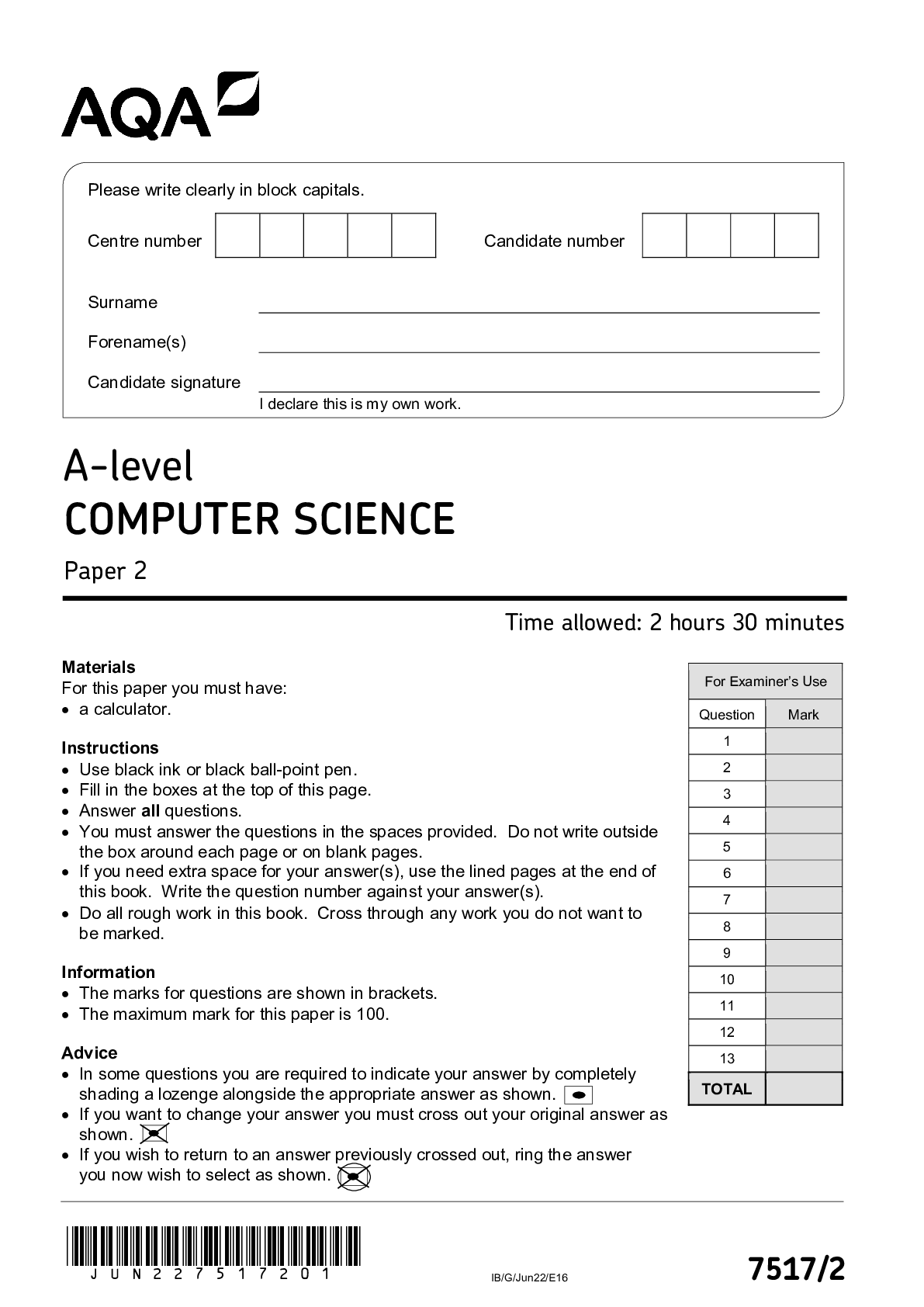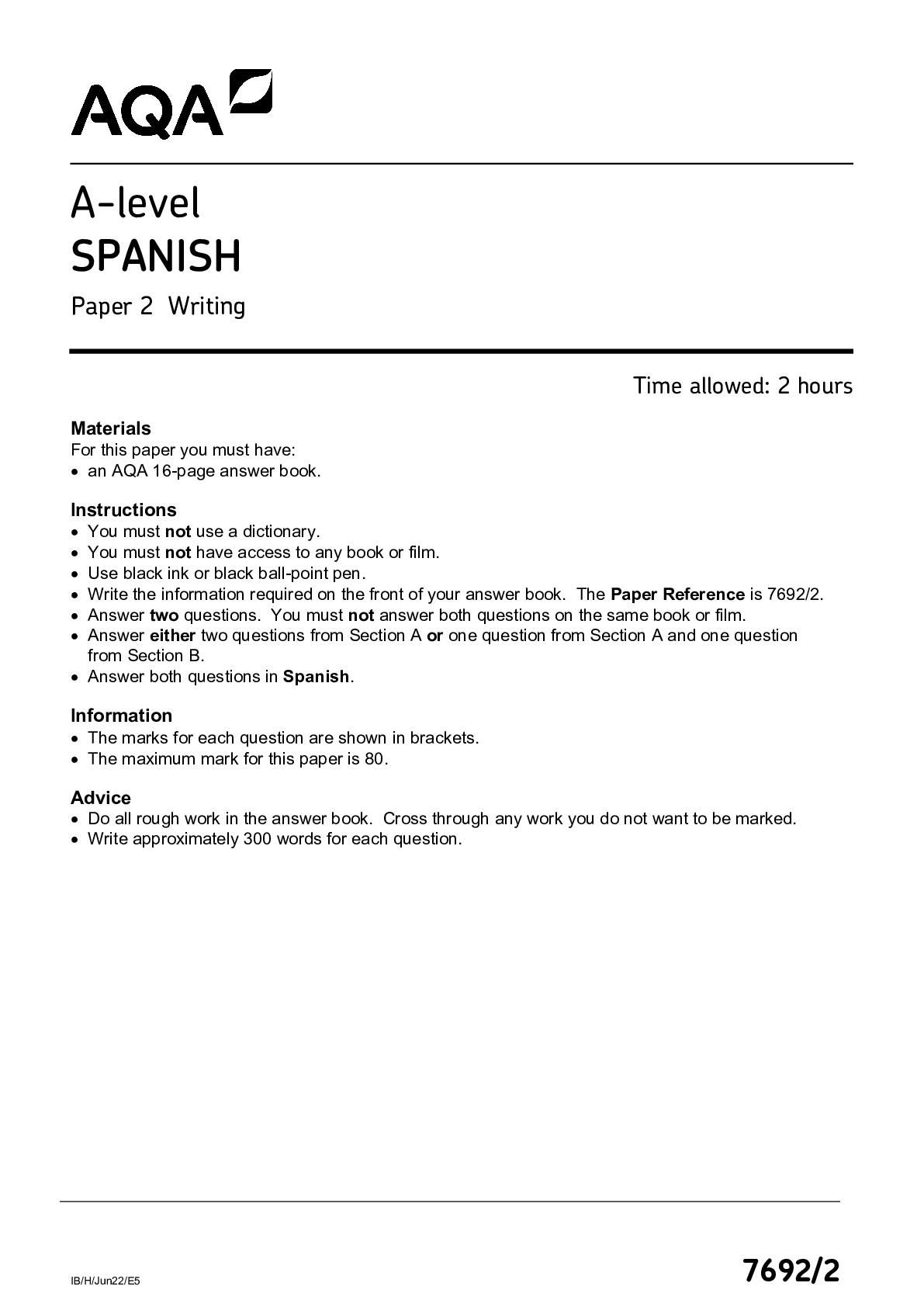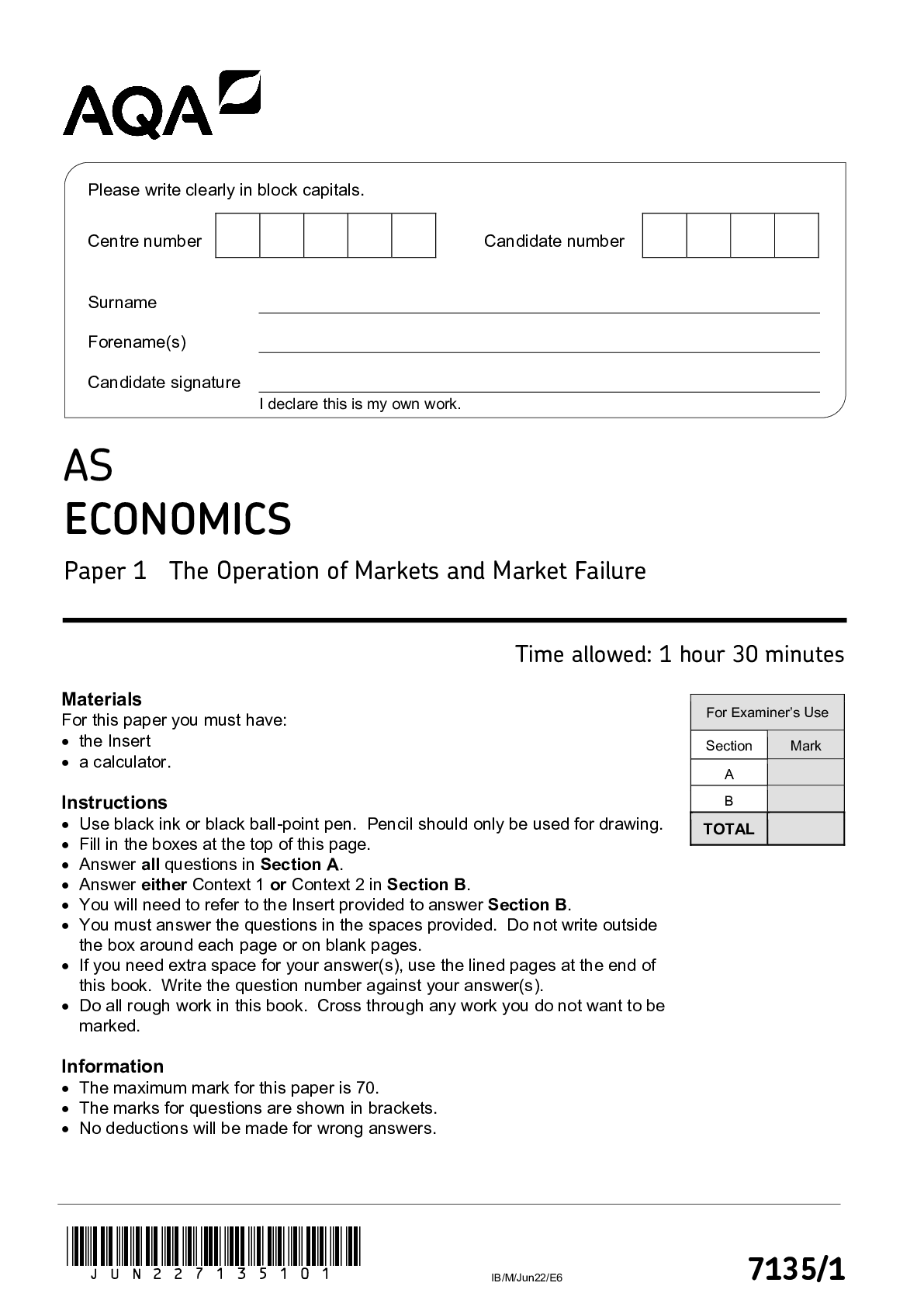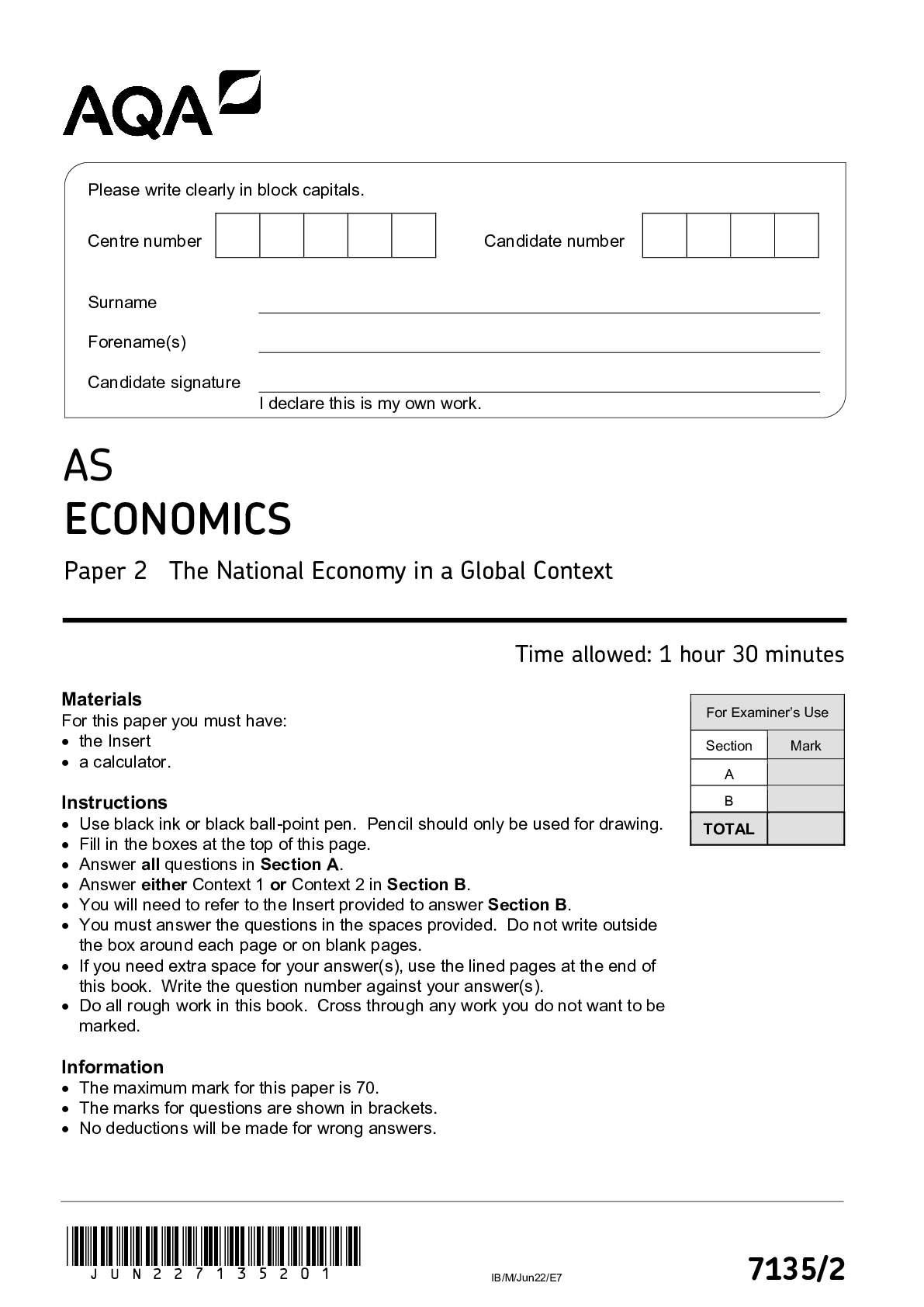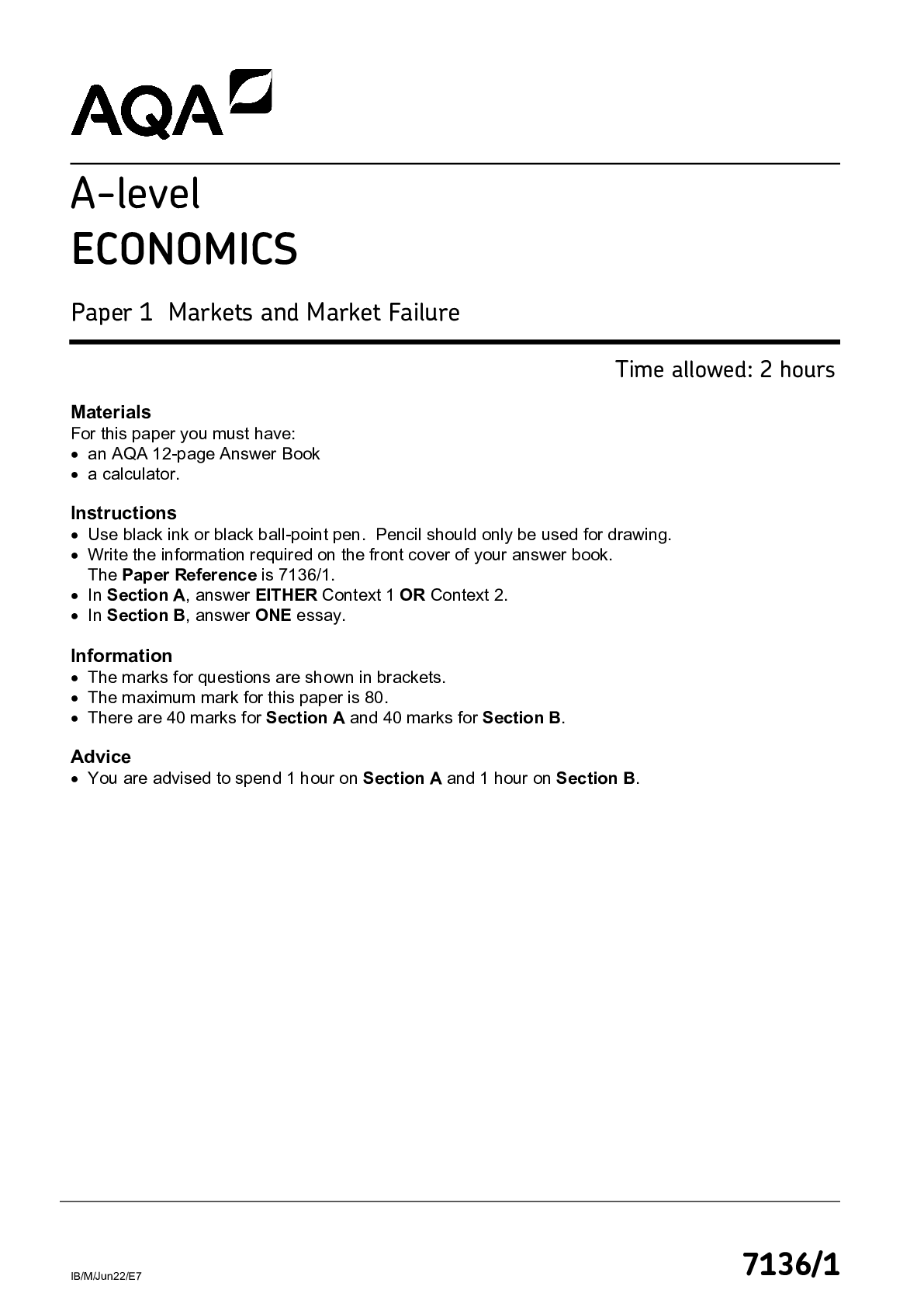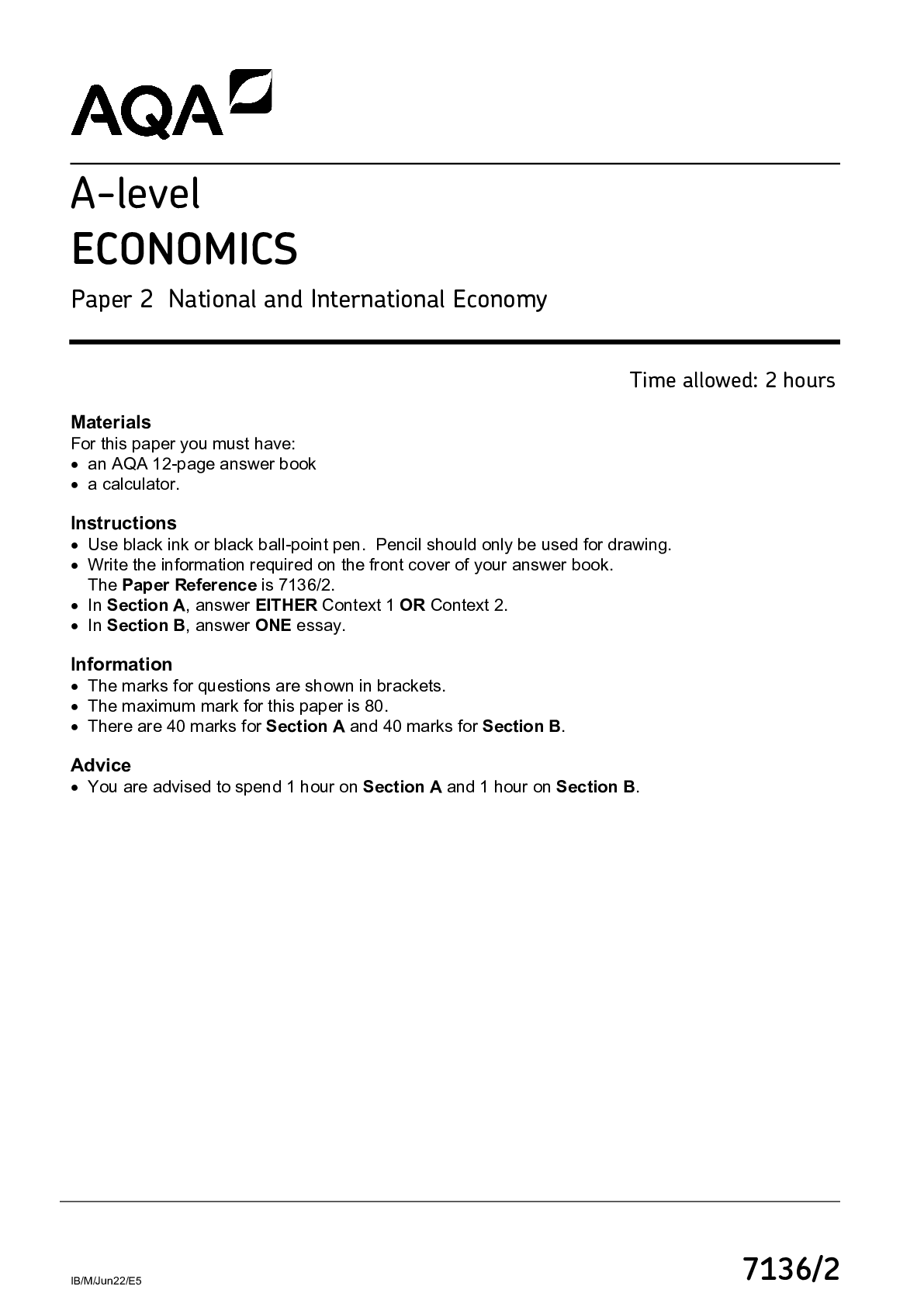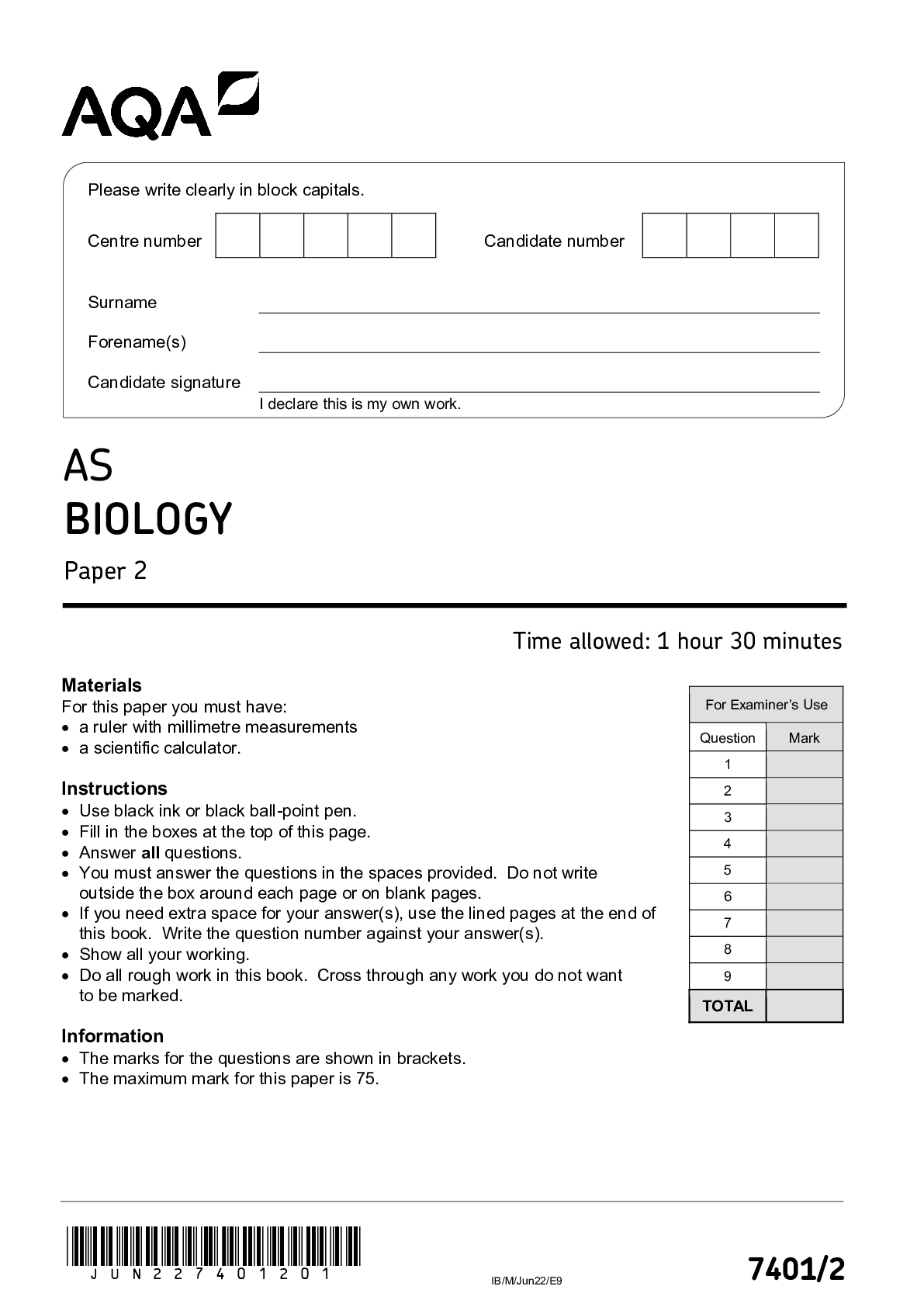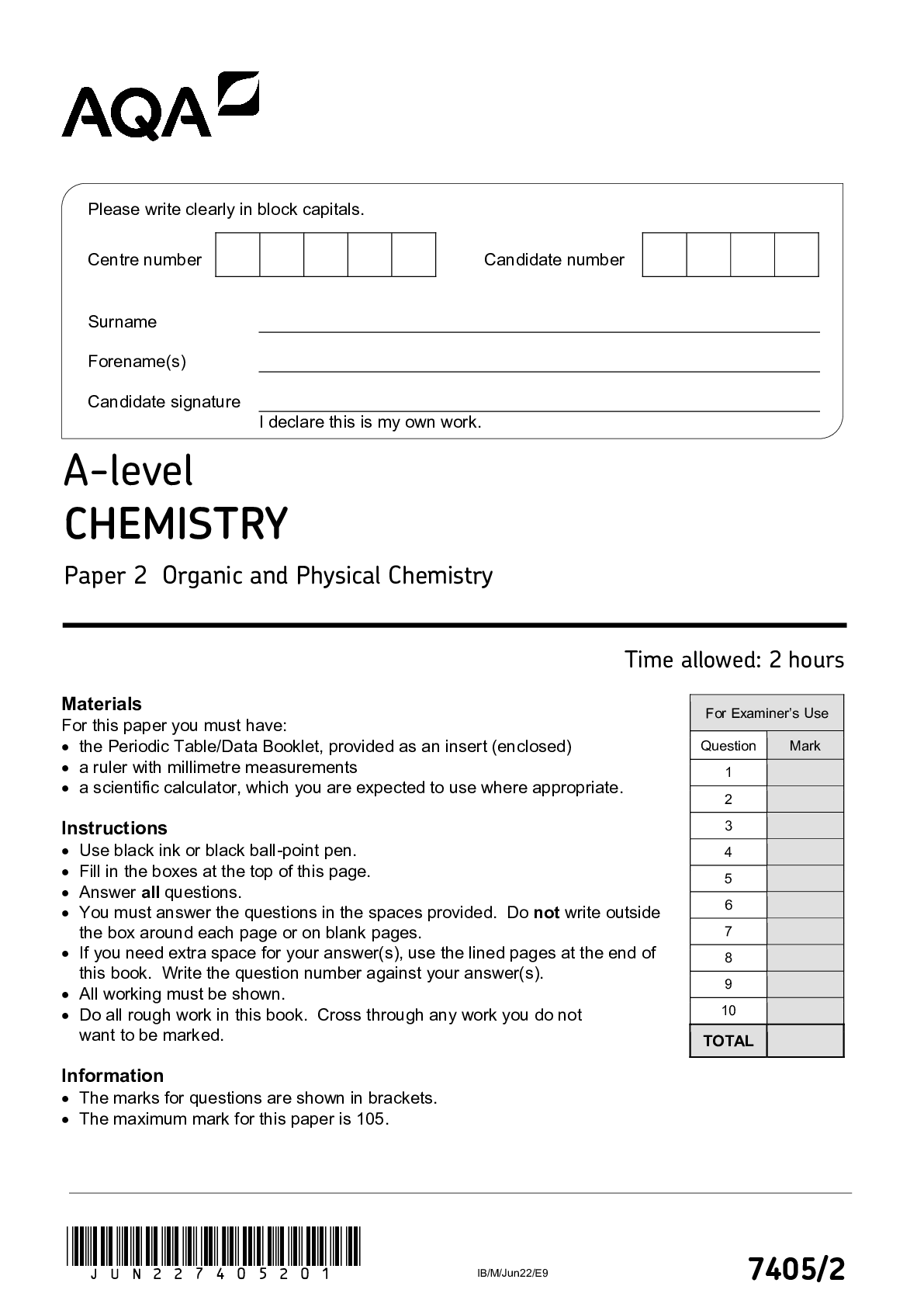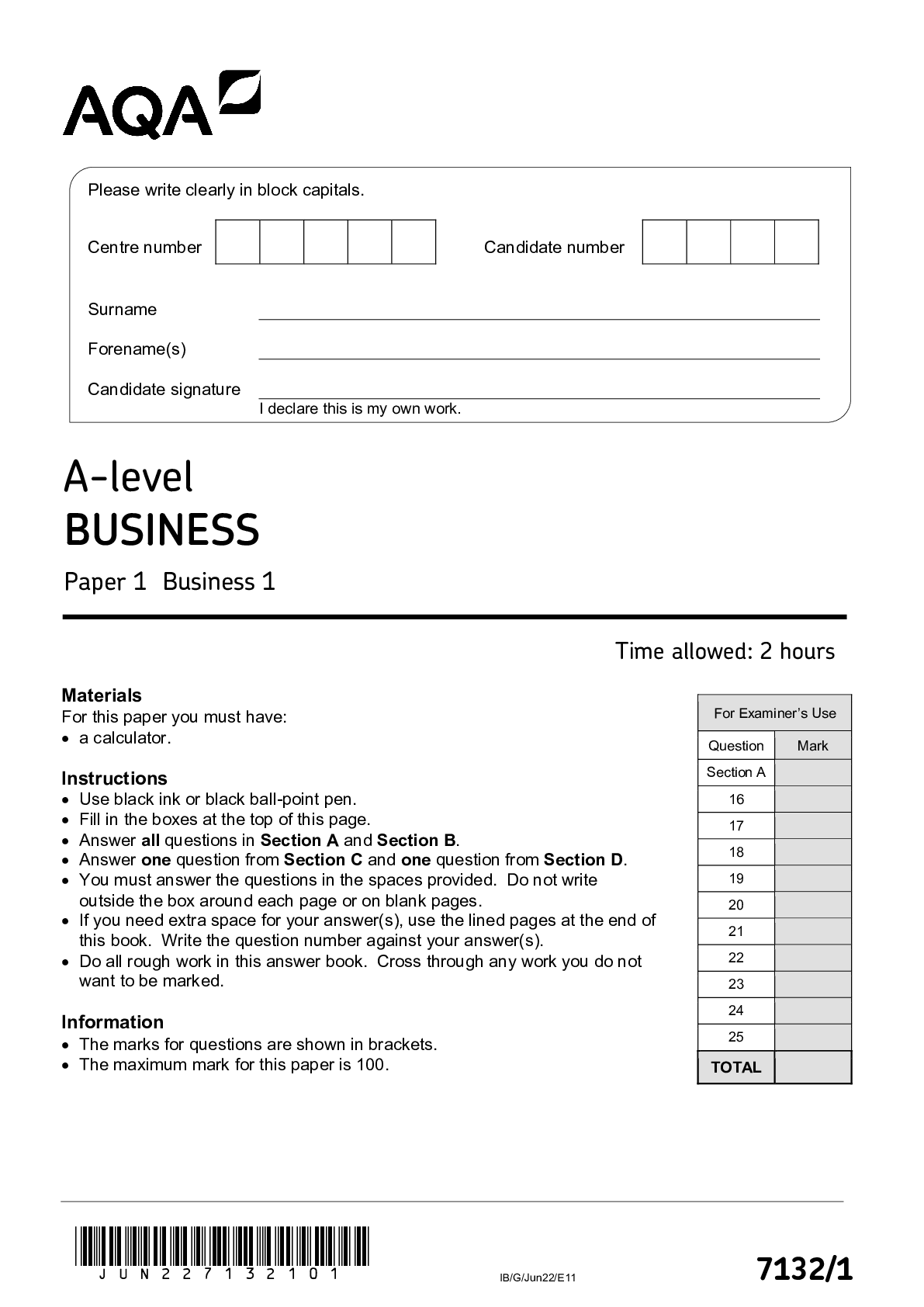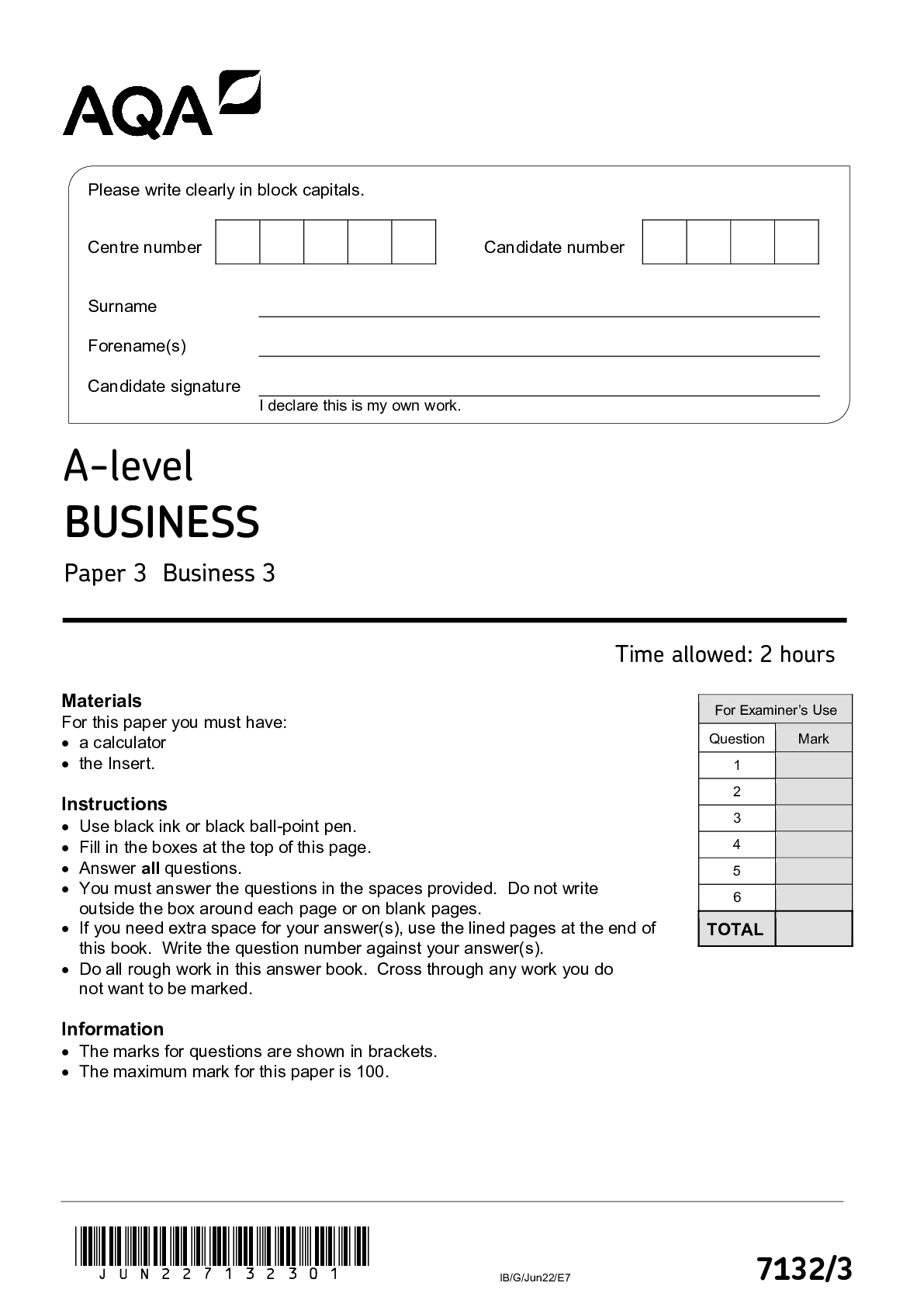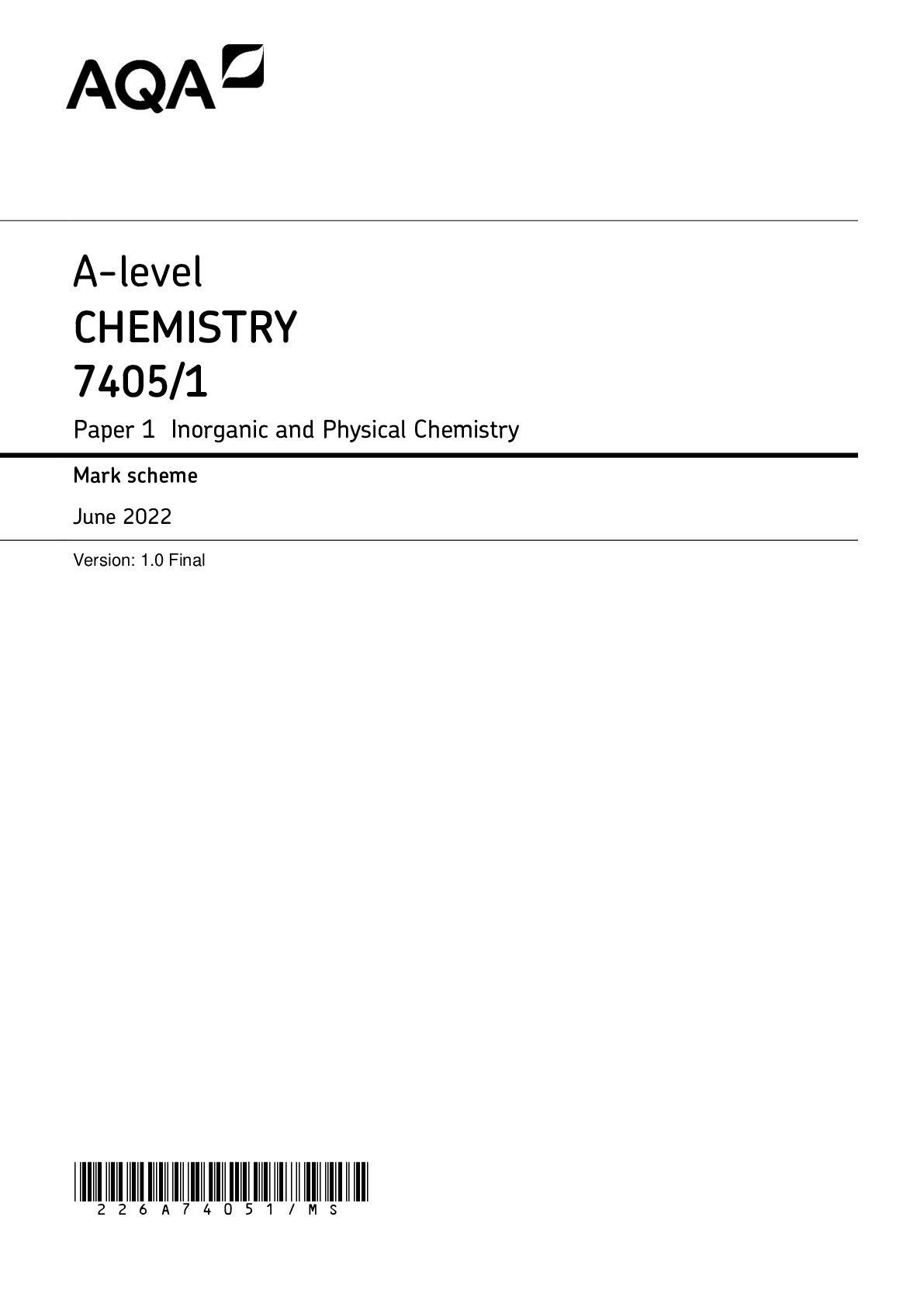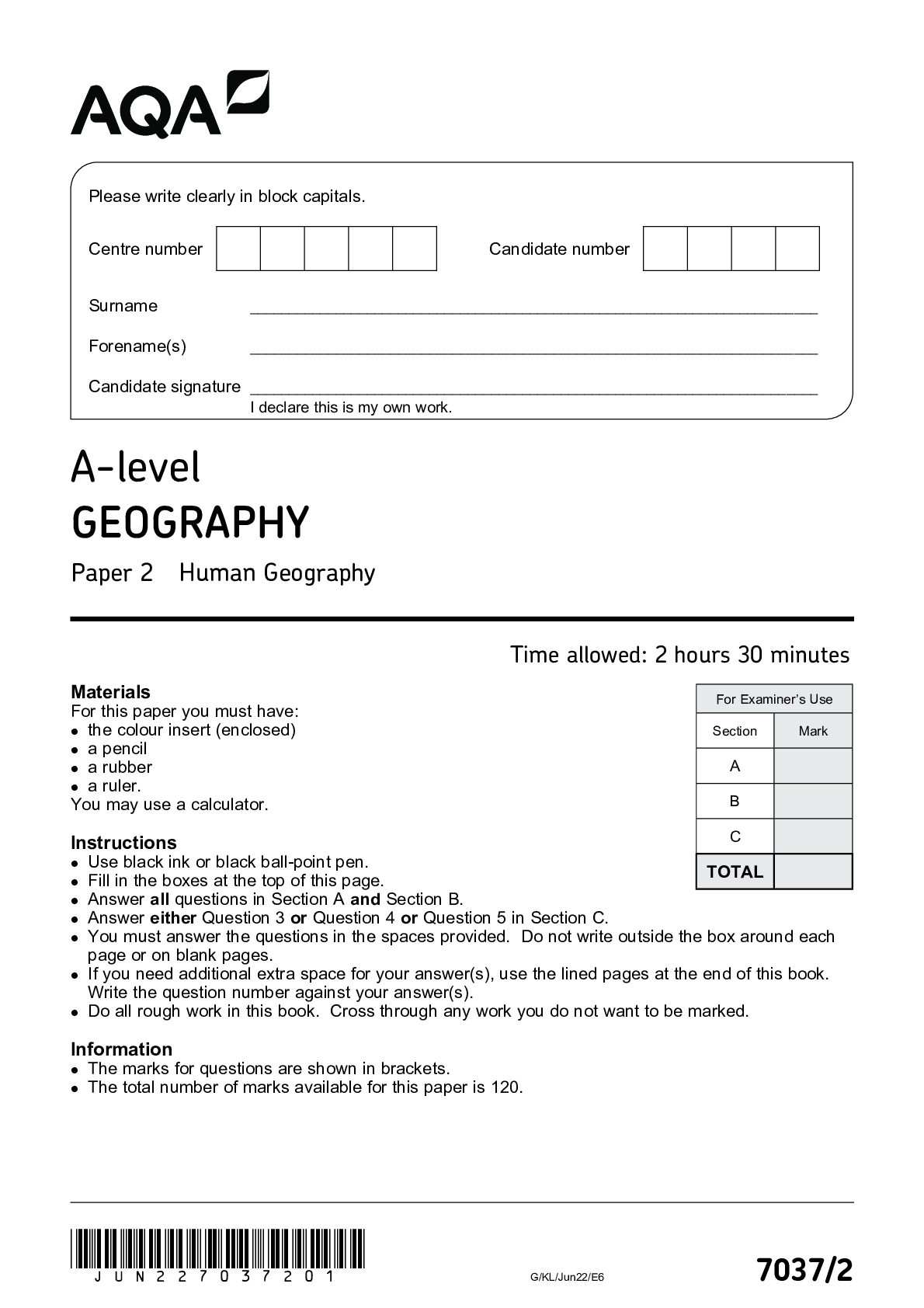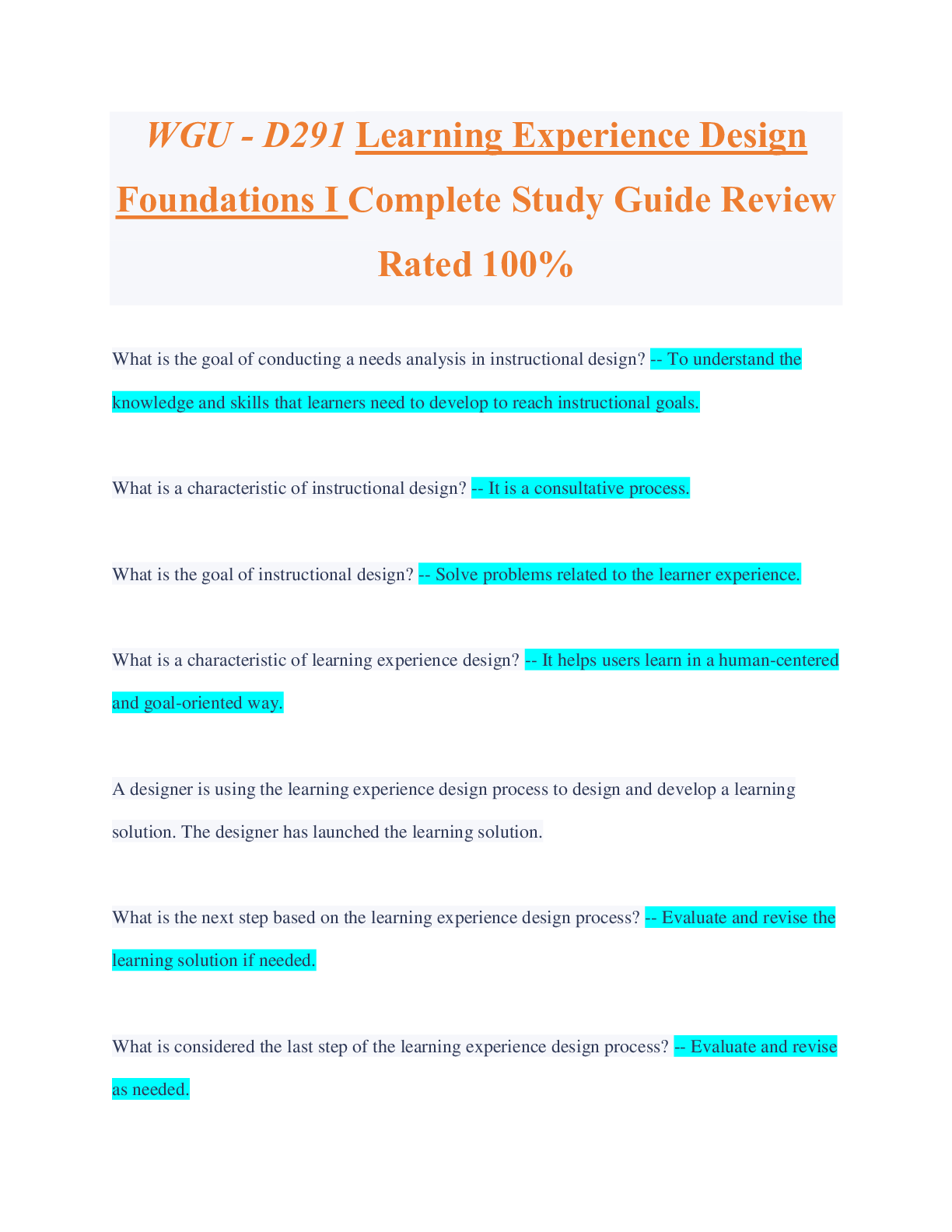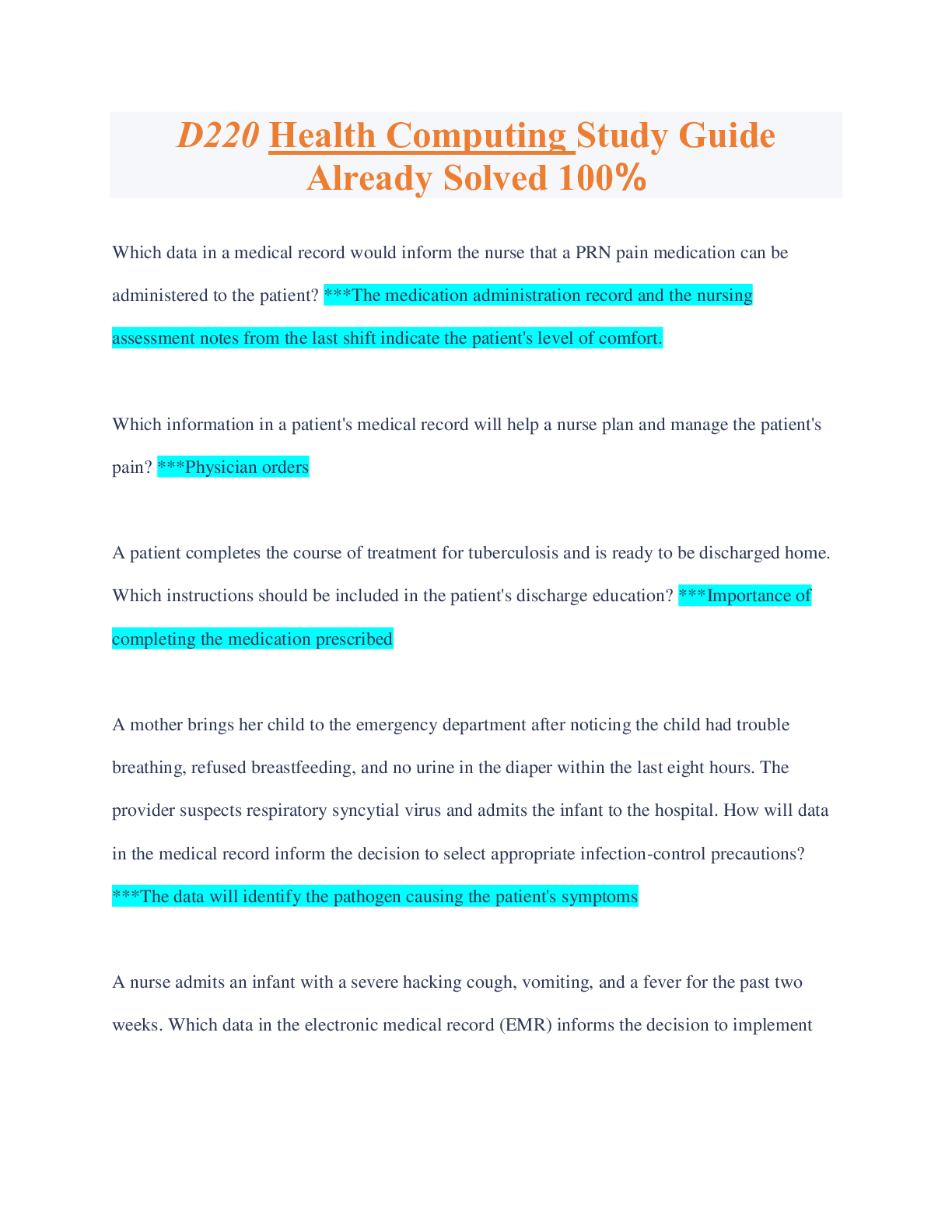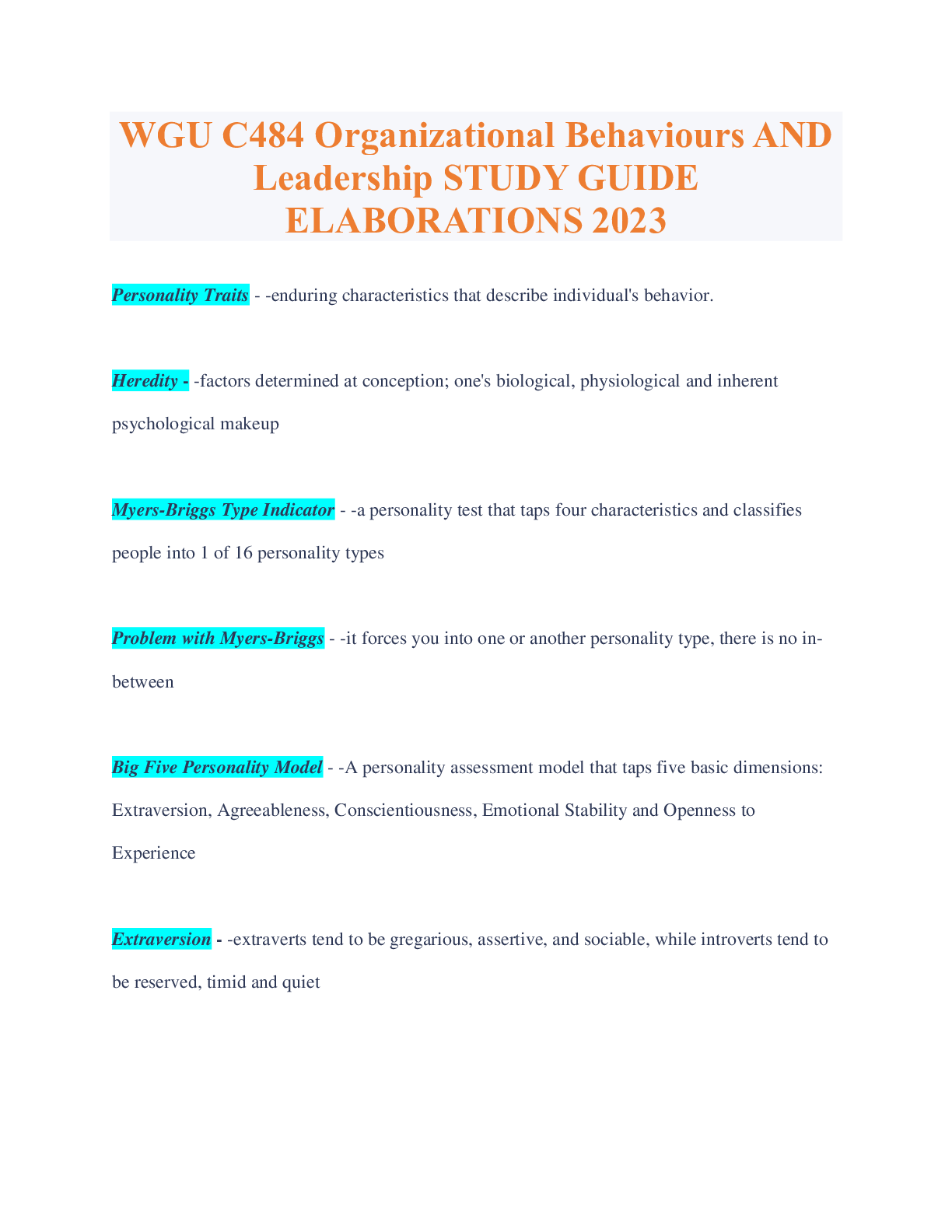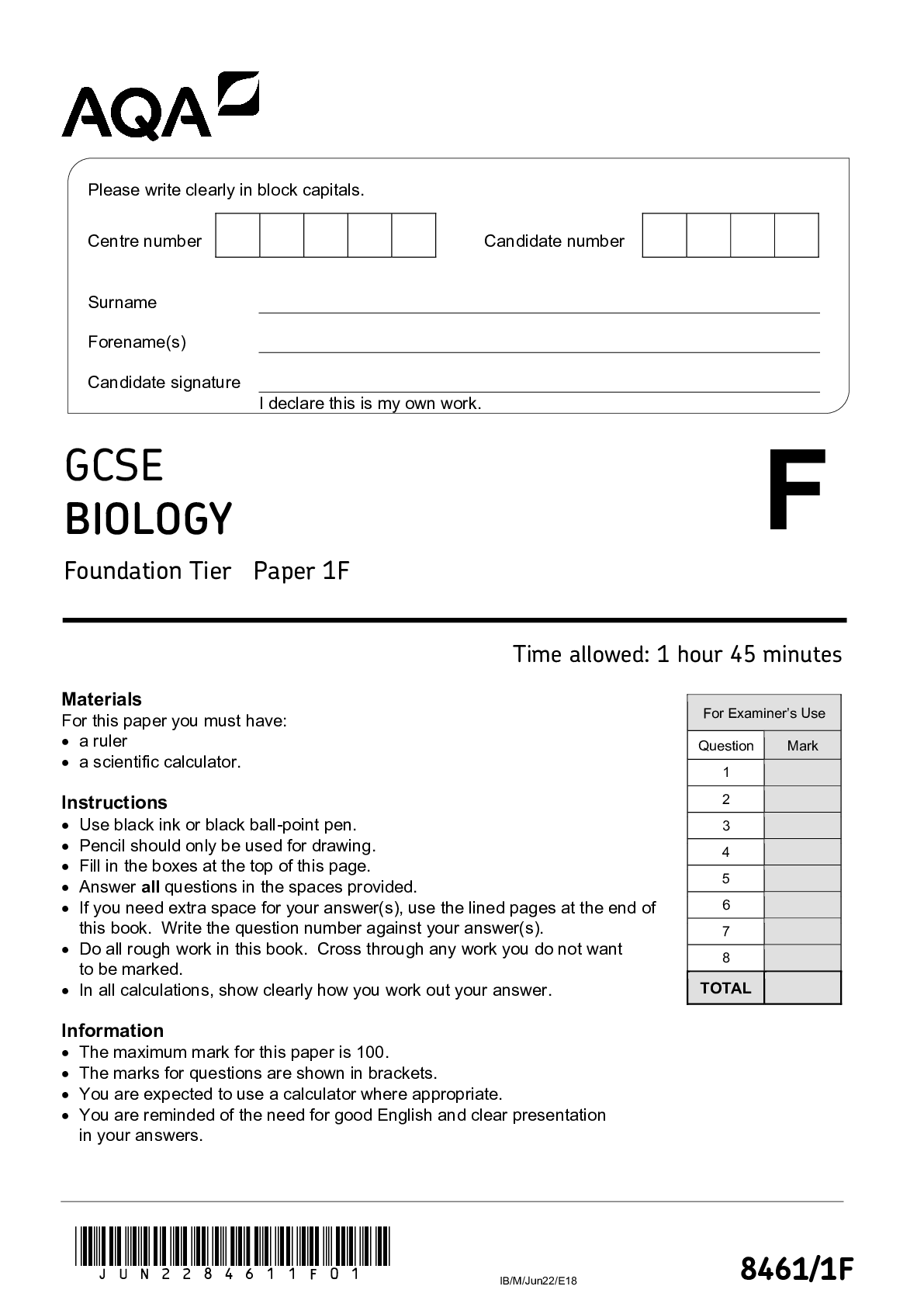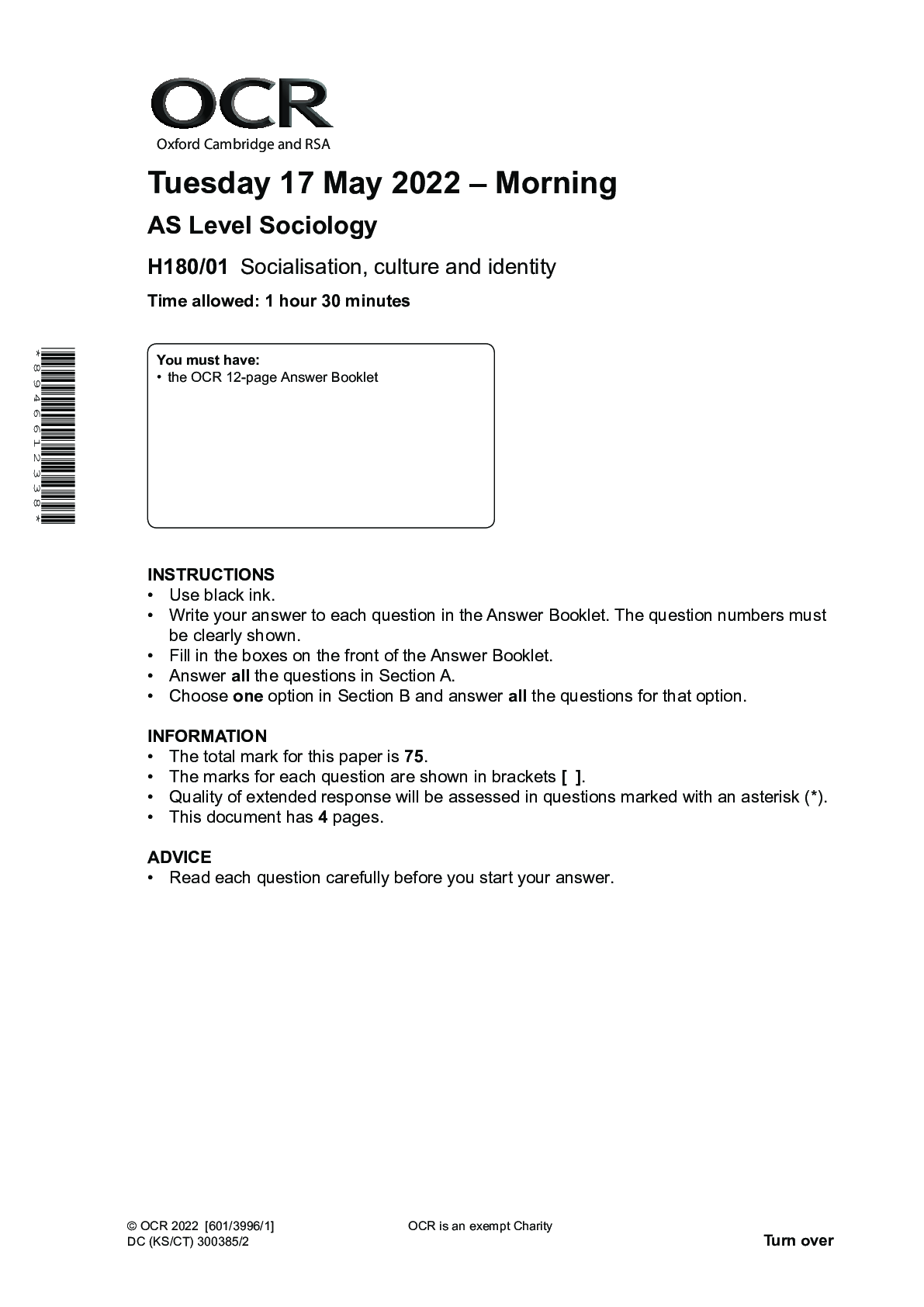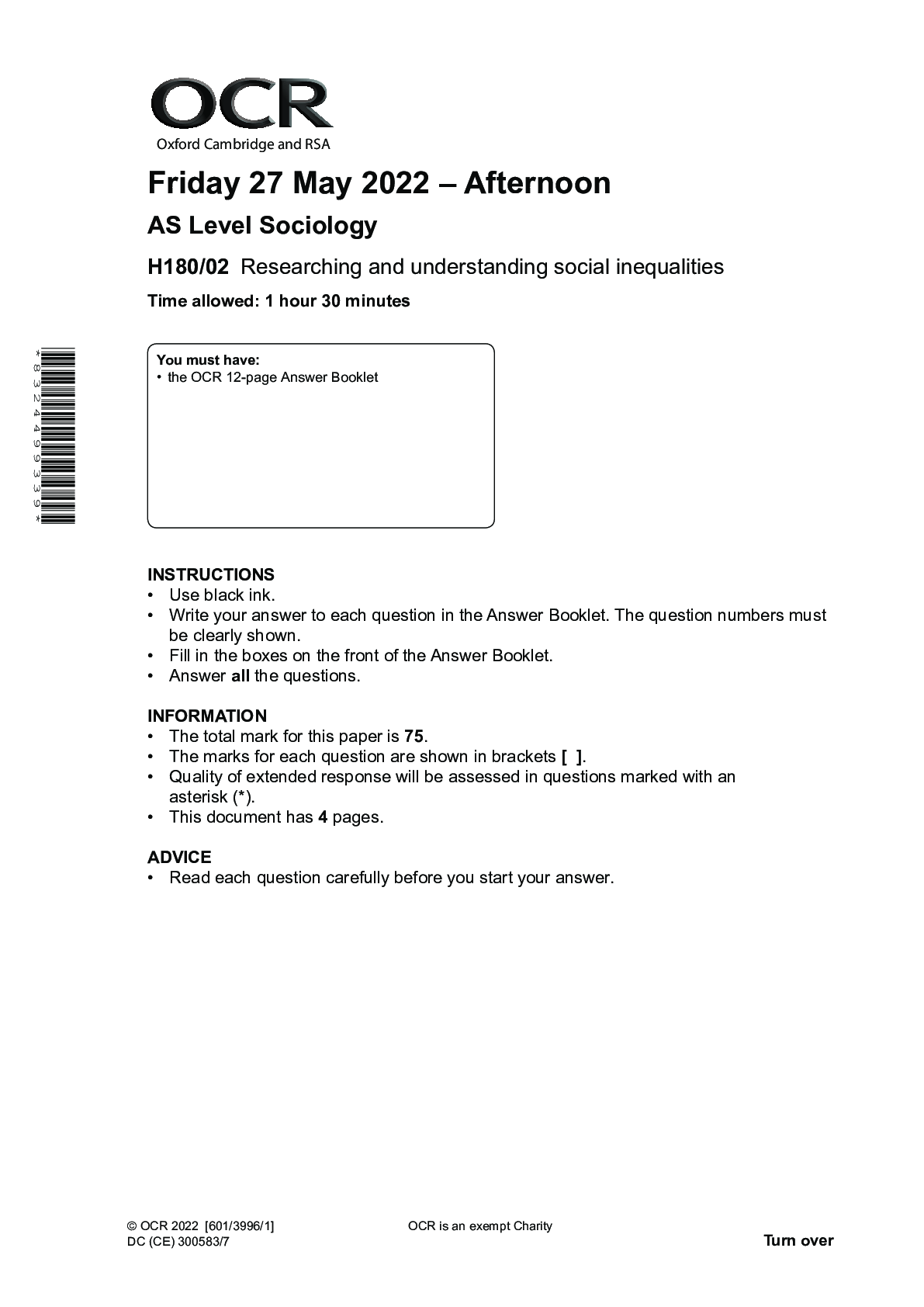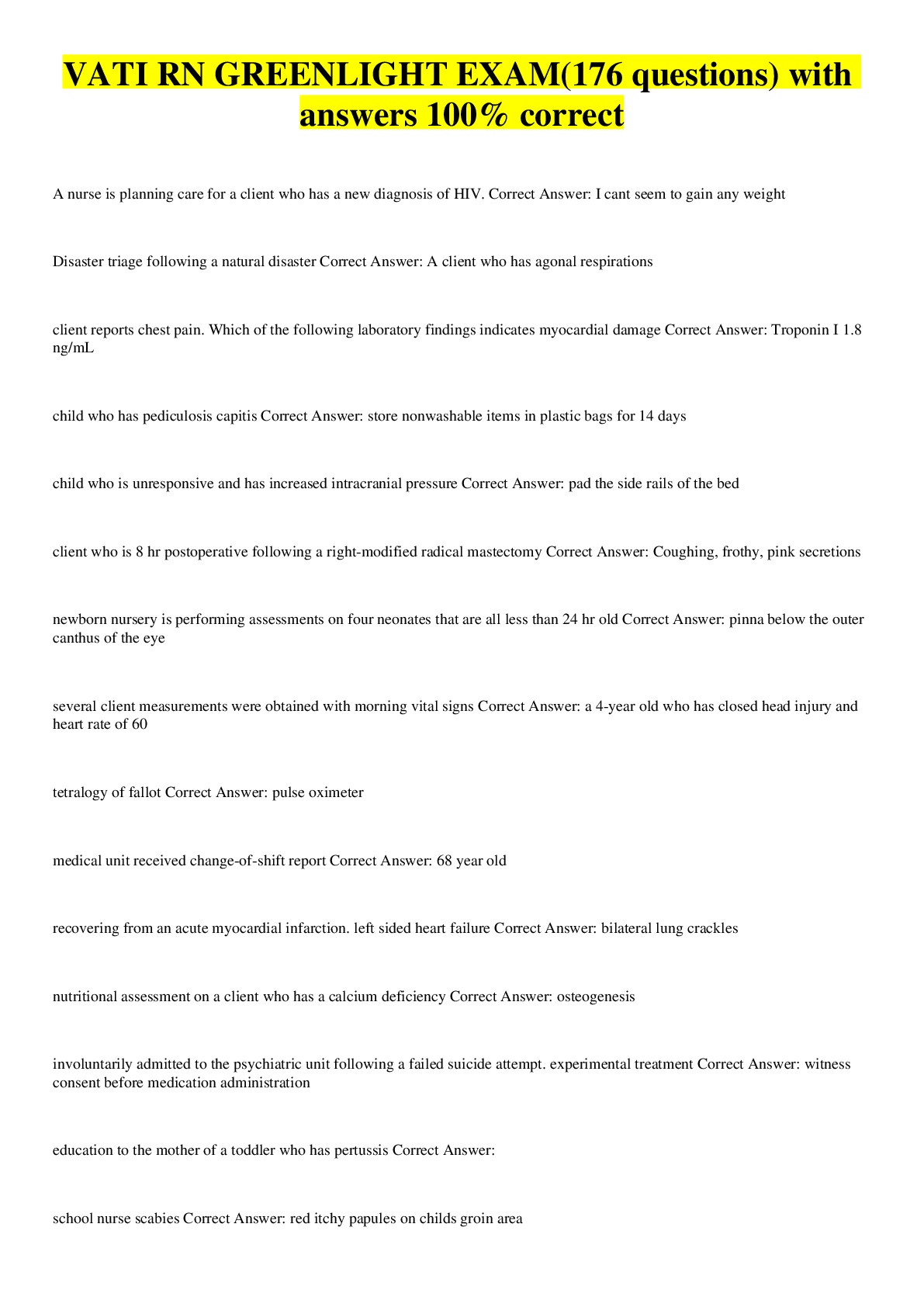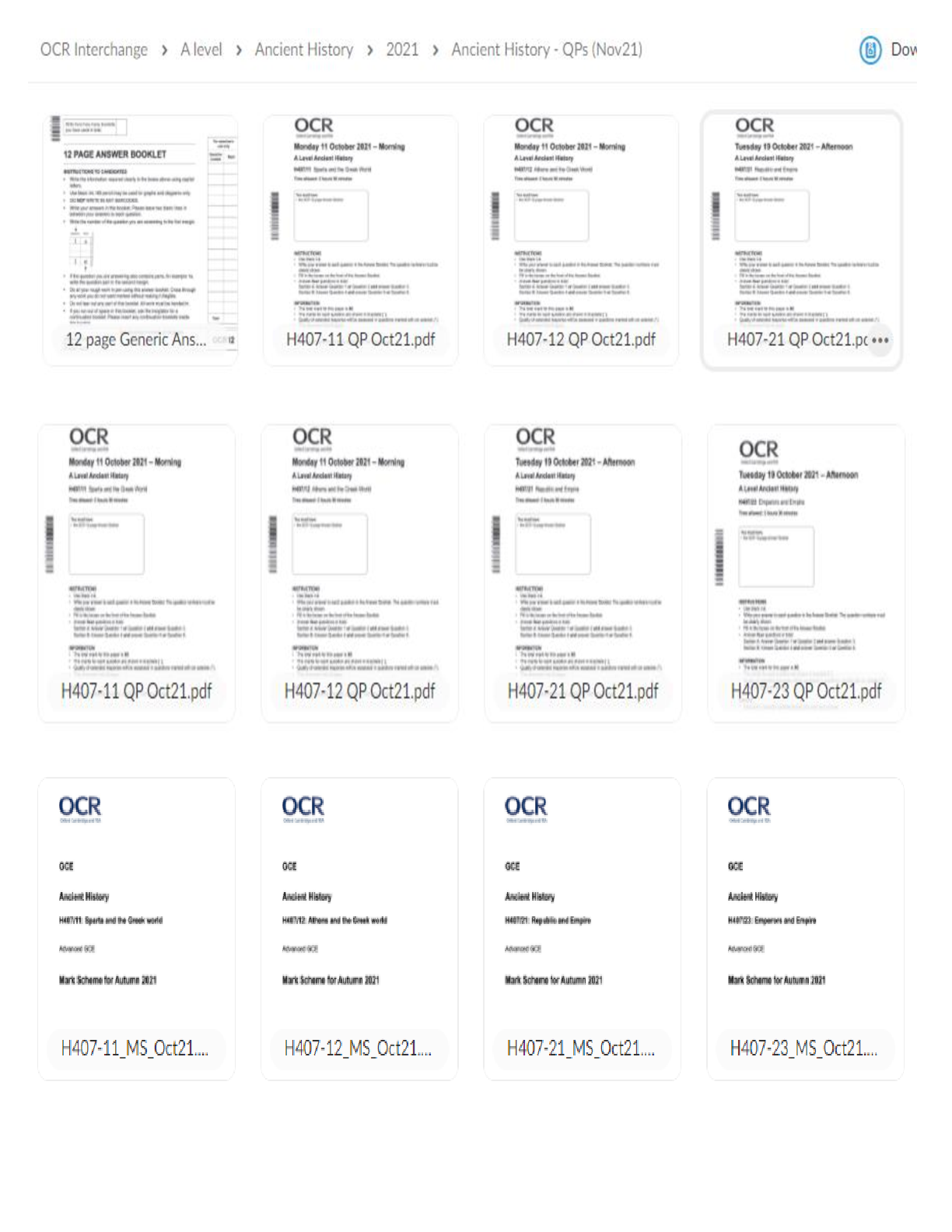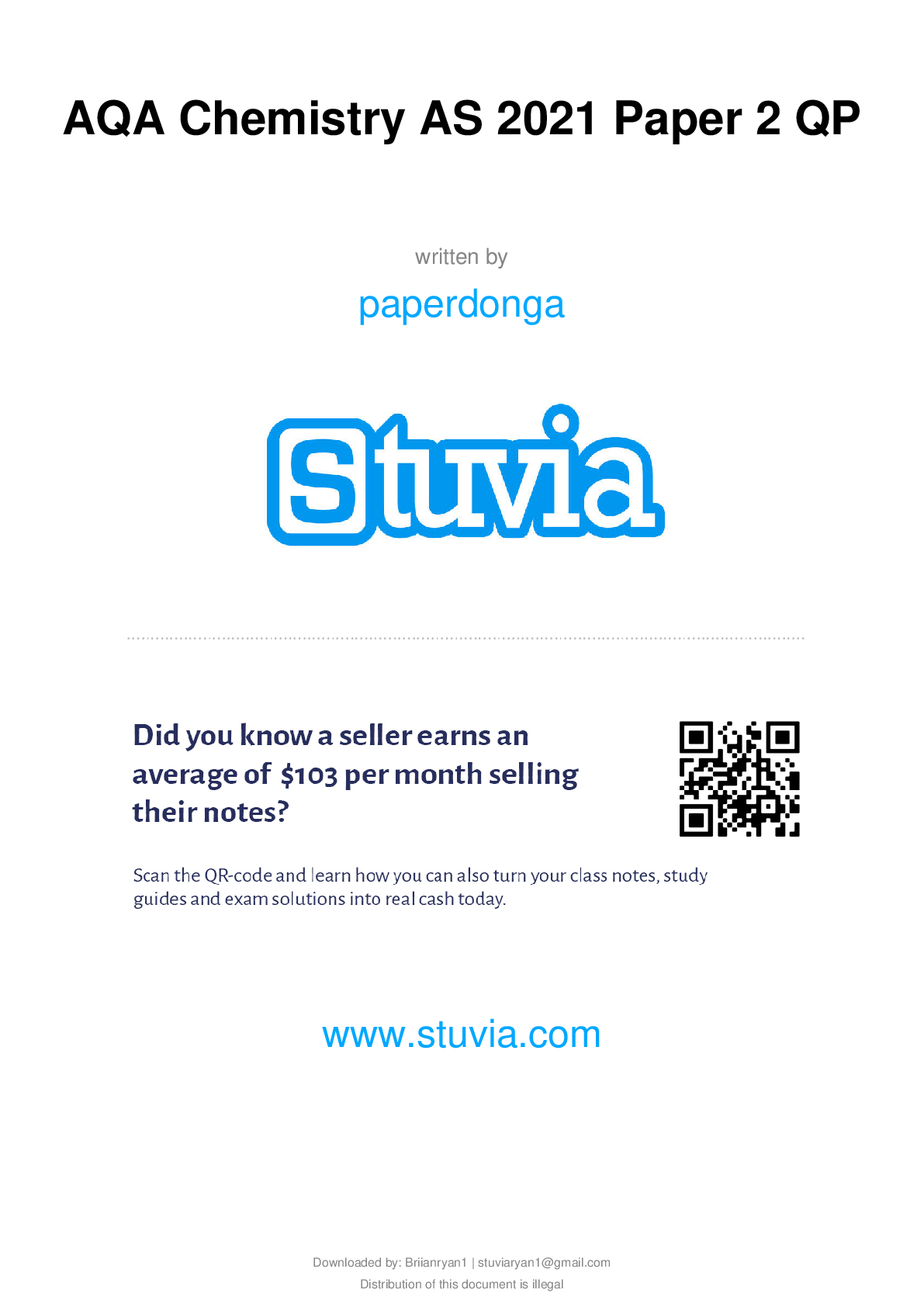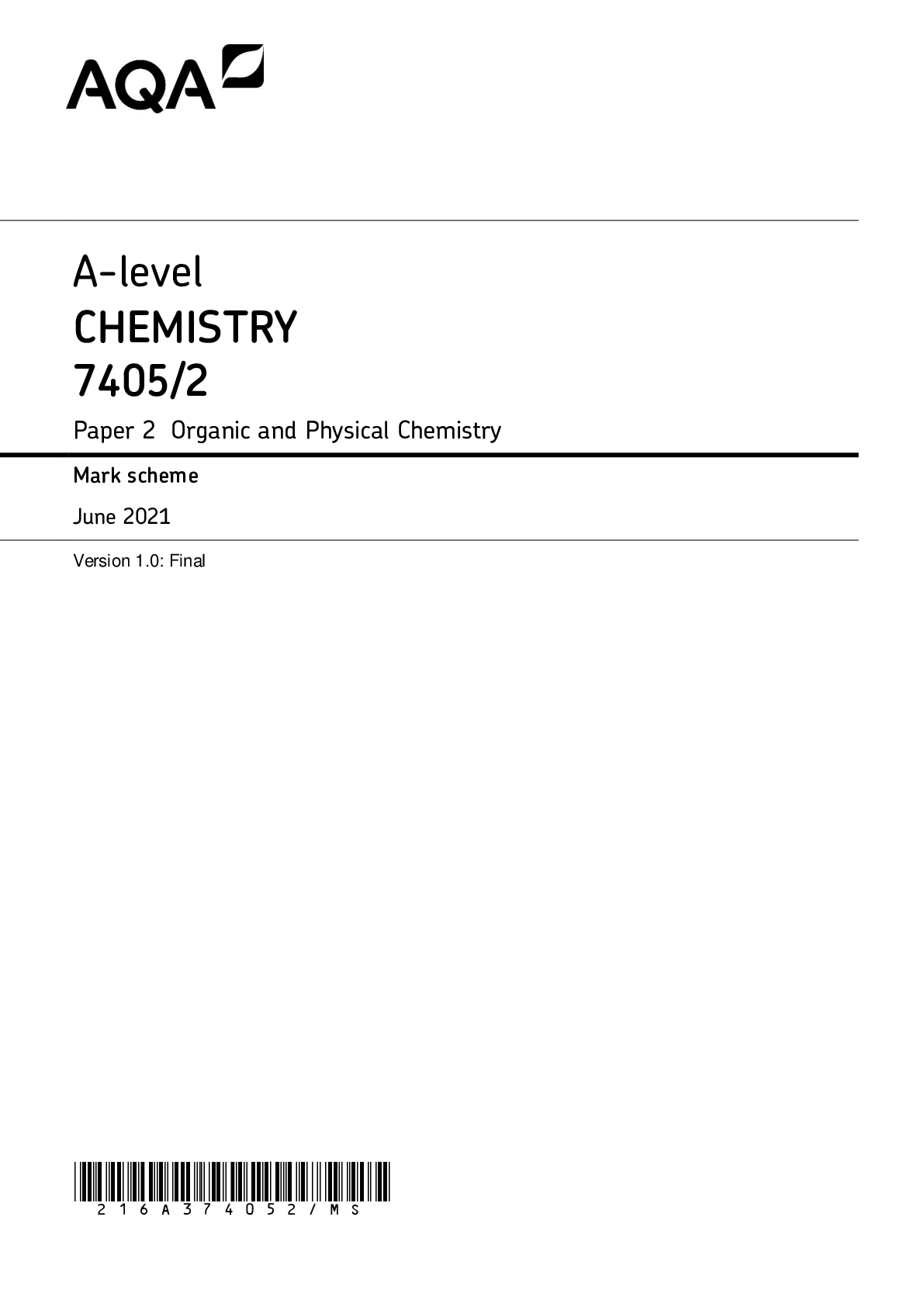Economics > AQA A/As Level Question Paper > A-level ECONOMICS 7136/3 Paper 3 Economic Principles and Issues Mark scheme June 2022 Version 1.0 Fi (All)
A-level ECONOMICS 7136/3 Paper 3 Economic Principles and Issues Mark scheme June 2022 Version 1.0 Final Mark Scheme *226A7136/3/MS* MARK SCHEME – A-LEVEL ECONOMICS – 7136/3 – JUNE 2022 2
Document Content and Description Below
A-level ECONOMICS 7136/3 Paper 3 Economic Principles and Issues Mark scheme June 2022 Version 1.0 Final Mark Scheme *226A7136/3/MS* MARK SCHEME – A-LEVEL ECONOMICS – 7136/3 – JUNE 2022 ... 2 Mark schemes are prepared by the Lead Assessment Writer and considered, together with the relevant questions, by a panel of subject teachers. This mark scheme includes any amendments made at the standardisation events which all associates participate in and is the scheme which was used by them in this examination. The standardisation process ensures that the mark scheme covers the students’ responses to questions and that every associate understands and applies it in the same correct way. As preparation for standardisation each associate analyses a number of students’ scripts. Alternative answers not already covered by the mark scheme are discussed and legislated for. If, after the standardisation process, associates encounter unusual answers which have not been raised they are required to refer these to the Lead Examiner. It must be stressed that a mark scheme is a working document, in many cases further developed and expanded on the basis of students’ reactions to a particular paper. Assumptions about future mark schemes on the basis of one year’s document should be avoided; whilst the guiding principles of assessment remain constant, details will change, depending on the content of a particular examination paper. Further copies of this mark scheme are available from aqa.org.uk Copyright information AQA retains the copyright on all its publications. However, registered schools/colleges for AQA are permitted to copy material from this booklet for their own internal use, with the following important exception: AQA cannot give permission to schools/colleges to photocopy any material that is acknowledged to a third party even for internal use within the centre. Copyright © 2022 AQA and its licensors. All rights reserved. MARK SCHEME – A-LEVEL ECONOMICS – 7136/3 – JUNE 2022 3 SECTION A KEY LIST 1 D (may be true or false) 11 B (Most banks carry out both commercial and investment banking activities.) 21 D (Total utility is maximised.) 2 C (Moving products with a high sugar content away from supermarket checkouts) 12 C (A natural disaster, damaging productive capacity) 22 C (Increasing, Increasing, Increasing) 3 A (greater at X than Y) 13 A (Helping countries settle disputes over tariffs and quotas) 23 C (£264 billion) 4 C (3.3%) 14 D (There is considerable spare capacity in the car industry.) 24 A (make supernormal profits) 5 C (price levels) 15 B 25 B ( 1 40) 6 C (Rates of income tax) 16 C (The income of some households is significantly less than the median household income.) 26 B (£100 bn) 7 B (Producers will be more likely to have to pay compensation for pollution.) 17 D (regressive tax) 27 B (The cost of living for people who live in UK seaside towns will fall.) 8 C (The firm’s total revenue falls.) 18 A (Government retraining schemes for structurally unemployed workers) 28 A (The total amount paid in wages will fall from (W2 × Q2 ) to (W3 × Q1 ).) 9 C (price discrimination) 19 C (5 + 6) 29 C (Increasing life expectancy at birth) 10 A (5%) 20 A (Average revenue and marginal revenue will both fall.) 30 C (geographical immobility of labour) MARK SCHEME – A-LEVEL ECONOMICS – 7136/3 – JUNE 2022 4 Level of response marking instructions Level of response mark schemes are broken down into levels, each of which has a descriptor. The descriptor for the level shows the average performance for the level. There are marks in each level. Before you apply the mark scheme to a student’s answer read through the answer and annotate it (as instructed) to show the qualities that are being looked for. You can then apply the mark scheme. Step 1 Determine a level Start at the lowest level of the mark scheme and use it as a ladder to see whether the answer meets the descriptor for that level. The descriptor for the level indicates the different qualities that might be seen in the student’s answer for that level. If it meets the lowest level then go to the next one and decide if it meets this level, and so on, until you have a match between the level descriptor and the answer. With practice and familiarity you will find that for better answers you will be able to quickly skip through the lower levels of the mark scheme. When assigning a level you should look at the overall quality of the answer and not look to pick holes in small and specific parts of the answer where the student has not performed quite as well as the rest. If the answer covers different aspects of different levels of the mark scheme you should use a best fit approach for defining the level and then use the variability of the response to help decide the mark within the level, ie if the response is predominantly level 3 with a small amount of level 4 material it would be placed in level 3 but be awarded a mark near the top of the level because of the level 4 content. Step 2 Determine a mark Once you have assigned a level you need to decide on the mark. The descriptors on how to allocate marks can help with this. The exemplar materials used during standardisation will help. There will be an answer in the standardising materials which will correspond with each level of the mark scheme. This answer will have been awarded a mark by the Lead Examiner. You can compare the student’s answer with the example to determine if it is the same standard, better or worse than the example. You can then use this to allocate a mark for the answer based on the Lead Examiner’s mark on the example. You may well need to read back through the answer as you apply the mark scheme to clarify points and assure yourself that the level and the mark are appropriate. Indicative content in the mark scheme is provided as a guide for examiners. It is not intended to be exhaustive and you must credit other valid points. Students do not have to cover all of the points mentioned in the Indicative content to reach the highest level of the mark scheme. An answer which contains nothing of relevance to the question must be awarded no marks. MARK SCHEME – A-LEVEL ECONOMICS – 7136/3 – JUNE 2022 5 SECTION B INVESTIGATION Total for this investigation: 50 marks 3 1 To what extent do the data support the view that Boeing has been more successful than Airbus since 2014? You must use the data in Extract B to support your assessment. [10 marks] Level of response Response Max 10 marks Level 3 A good response that: • is well organised and includes at least three relevant, well-developed issues • makes effective use of the numerical/statistical data in Extract B • shows some appreciation of the limitations of the data • includes a supported final judgement concerning the extent to which the data support the view that Boeing has been more successful than Airbus since 2014. 8–10 marks Level 2 A reasonable response that: • is fairly well organised and includes at least two relevant and fairly well-developed issues • includes some satisfactory use of the numerical/statistical data in Extract B • may show some appreciation of the limitations of the data • at the top of the level, is likely to include a final judgement regarding the extent to which the data support the view that Boeing has been more successful than Airbus since 2014. 4–7 marks Level 1 A weak response that: • is very brief and/or lacks coherence • may include one or more superficial points regarding the extent to which the data suggest that Boeing has been more successful than Airbus since 2014 • contains very limited or poor use of the data in Extract B • doesn’t show any appreciation of the limitations of the data • may include an unsupported judgement concerning the extent to which Boeing has been more successful than Airbus since 2014. 1–3 marks When assessing the extent to which the data support the view that Boeing has been more successful than Airbus since 2014, most students are likely to base their assessment on the data in Extract B. However, they can also be rewarded for making relevant use of the other extracts and their own knowledge. MARK SCHEME – A-LEVEL ECONOMICS – 7136/3 – JUNE 2022 6 Relevant issues include: • explanation of the market that Boeing and Airbus are in • explanation of the criteria that might be used to judge the relative success of Boeing and Airbus, eg deliveries of aircraft, changing market share, profitability • each year, between 2014 and 2018, Boeing delivered more aeroplanes than Airbus but generally the gap has been falling, eg from 94 aeroplanes in 2014 to just 6 aeroplanes in 2018 • the total number of aeroplanes delivered, between 2014 and 2018, by Boeing (3802) was more than Airbus (3470) delivered • Airbus delivered 863 planes in 2019 but Boeing’s deliveries fell to 380, however, this was due to the grounding of the 737 MAX • in 2018, Airbus had a larger backlog of outstanding orders than Boeing, 7133 planes as opposed to 5488 planes • between 2014 and 2018, in terms of deliveries, Boeing had a larger market share than Airbus but Boeing’s market share fell from 47.3% to 45.7% whilst Airbus’s market share grew from 41.1% to 45.4% • on balance, data relating to deliveries, market share and orders suggest that the performance of Airbus improved relative to Boeing over the period • between 2014 and 2018, in each year, Boeing’s total revenue was greater than Airbus’s total revenue but the difference fluctuated. Over the five years, Boeing’s total revenue was $304.1 billion whereas Airbus’s total revenue was $275.9 billion • between 2014 and 2018, in each year, Boeing’s profit margin was greater than Airbus’s profit margin but whilst the difference fluctuated, the difference between Boeing’s and Airbus’s profit margin was lower in 2018 (4%) than in 2014 (4.4%) • the average revenue per aircraft fell for both firms but it fell most for Airbus. Between 2014 and 2018, Boeing’s average revenue per aircraft fell by $7.7 million whereas Airbus’s average revenue per aircraft fell by $18.5 million • limitations of the data identified might, for example, include: o no indication of the total profit, although this can be estimated from Figure 3 o no indication of the amount of interest each company pays on its debt/borrowing o the reasons for the falls in average revenue per aircraft [Show More]
Last updated: 1 year ago
Preview 1 out of 12 pages
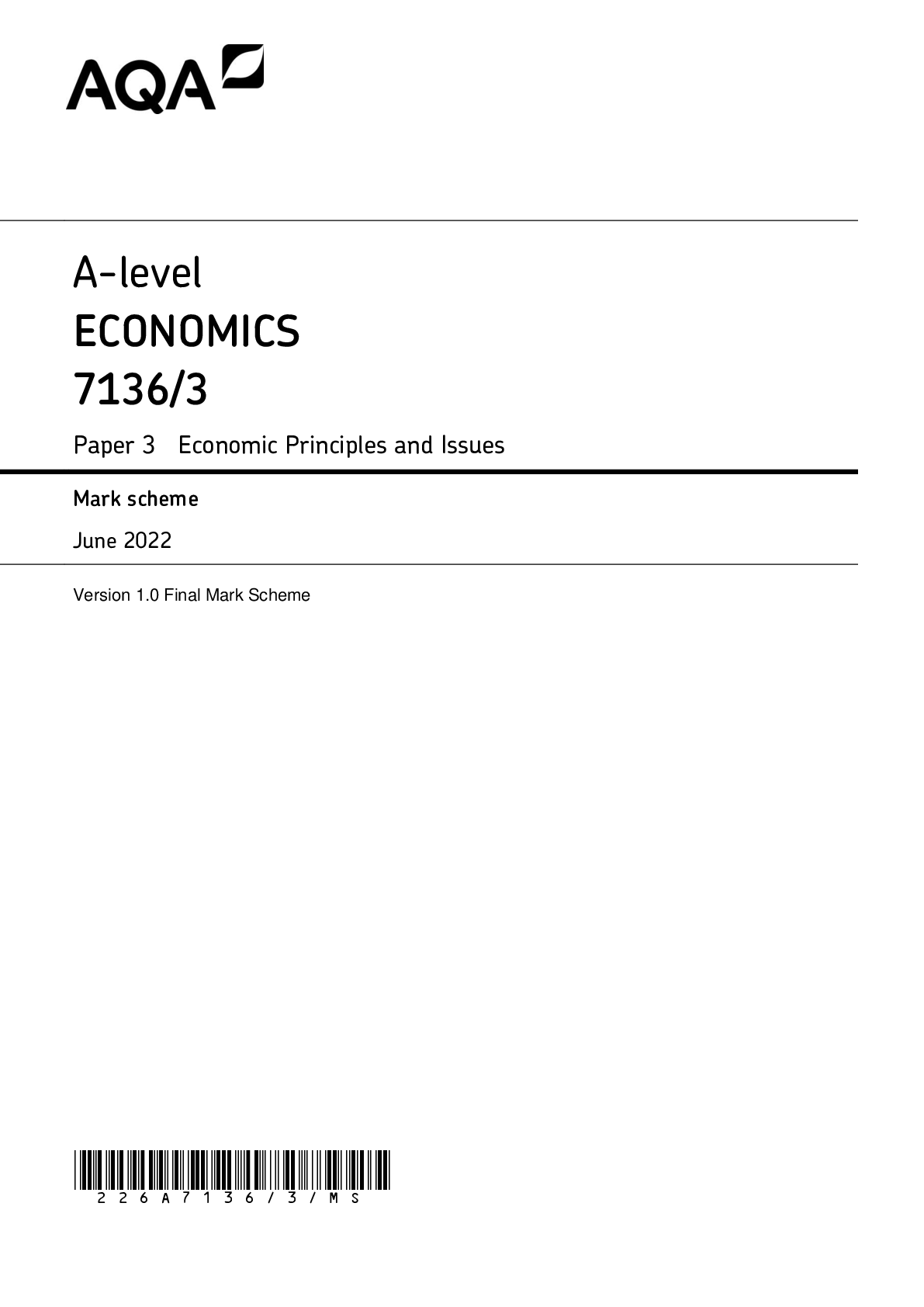
Reviews( 0 )
Document information
Connected school, study & course
About the document
Uploaded On
Apr 01, 2023
Number of pages
12
Written in
Additional information
This document has been written for:
Uploaded
Apr 01, 2023
Downloads
0
Views
77

